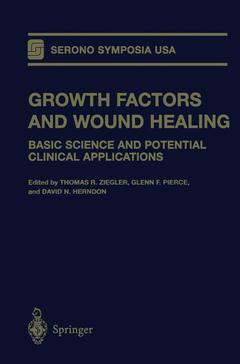Description
Growth Factors and Wound Healing, Softcover reprint of the original 1st ed. 1997
Basic Science and Potential Clinical Applications
Serono Symposia USA Series
Language: English
Subjects for Growth Factors and Wound Healing:
Keywords
growth; growth factor; growth hormone; hormone; hormone therapy; insulin-like
Publication date: 10-2012
366 p. · 15.5x23.5 cm · Paperback
366 p. · 15.5x23.5 cm · Paperback
Description
/li>Contents
/li>Comment
/li>
The biology of wound healing and tissue repair are increasingly being defined. At the same time, the availability of recombinant peptide growth factors for clinical investigation has prompted numerous trials of growth factor administration as adjunctive therapy to enhance the rate and quality of acute and chronic wound repair. New basic science information on growth factor function and regulation obtained in the research laboratory is actively being applied in animal studies and in clinical research settings. In addition to studies of surface wounds, an increasing number of investiga tions on growth factor administration have focused on healing and repair in nondermal tissues such as the intestinal tract and other organs. While the amount of new information on the molecular biology of growth factor expression, signaling, and function has been exponential in recent years, results of many clinical trials on growth factor administration in wound healing have been disappointing. This maybe due, in part, to the heterogeneity of clinical wounds and the patients who harbor them, less than adequate standardization of care in experimental and control groups, issues related to drug dosing, and inadequate control for important issues relevant to healing such as nutrient intake and underlying nutritional status.
I. General Concepts.- 1. An Overview of Wound Healing Biology.- 2. Growth Factors and Angiogenesis in Wound Healing.- 3. The Regulation of Basic Fibroblast Growth Factor (FGF-2) Through Limited Bioavailability.- 4. Cultured Skin Cells for Wound Closure and for Promoting Wound Healing.- 5. The Growth Hormone Insulin-Like Growth Factor-I Axis.- II. Role of Nutrients in Wound Healing Responses.- 6. Use of Exogenous Amino Acids in Wound Healing.- 7. Vitamin A-Growth Factor Interactions in Wound Healing.- 8. Interactions Between Nutrients and Growth Factors in Cellular Anabolism and Tissue Repair.- III. Endogenous Growth Factors and Wound Healing.- 9. Fibroblast Growth Factor Receptors.- 10. Arginine and Nitric Oxide (NO) Interactions in the Healing Wound.- 11. Endogenous Growth Factors and Nutrients in the Healing Wound.- 12. Epidermal Growth Factor in Wound Healing: A Model for the Molecular Pathogenesis of Chronic Wounds.- IV. Clinical Application of Growth Hormone and IGF-I Therapy.- 13. Growth Hormone Therapy in Human Burn Injury.- 14. Effects of Exogenous Growth Hormone in Postoperative Immune Function and Other Clinical Outcomes.- 15. Effect of Growth Hormone Administration on Colonic Healing and Repair.- 16. Modulation of IGF-I Therapy by IGFBP-3: Potential Utility in Wound Healing.- V. Clinical Application of Peptide Growth Factors.- 17. Roles of Keratinocyte Growth Factor in Epithelial Growth and Regeneration.- 18. Hepatocyte Growth Factor.- 19. The Biology of Vascular Endothelial Growth Factor, a Specific Regulator of Angiogenesis.- 20. FDA Regulatory Concerns for Wound Healing Biologics.- Author Index.
The aim of this symposium was to provide basic and clinical investigators with the latest information on the biology of wound healing and tissue repair. Written and edited by eminent experts in the field, the papers cover the general concepts of wound healing, the role of nutrients, endogenous growth factors, clinical applications of growth hormone and IGF-1 therapy, and clinical applications of peptide growth factors.
© 2024 LAVOISIER S.A.S.




